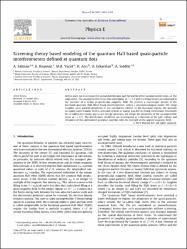| dc.contributor.author | Salman, A. | |
| dc.contributor.author | Koymen, E. | |
| dc.contributor.author | Yucel, M. B. | |
| dc.contributor.author | Atci, H. | |
| dc.contributor.author | Erkarslan, Uğur | |
| dc.contributor.author | Siddiki, Afif | |
| dc.date.accessioned | 2020-11-20T16:22:18Z | |
| dc.date.available | 2020-11-20T16:22:18Z | |
| dc.date.issued | 2012 | |
| dc.identifier.issn | 1386-9477 | |
| dc.identifier.uri | https://doi.org/10.1016/j.physe.2012.03.005 | |
| dc.identifier.uri | https://hdl.handle.net/20.500.12809/4134 | |
| dc.description | WOS: 000306196900055 | en_US |
| dc.description.abstract | In this work, we investigate the spatial distributions and the widths of the incompressible strips, i.e. the edge-states. The incompressible strips that correspond to nu = 1,2 and 1/3 filling factors are examined in the presence of a strong perpendicular magnetic field. We present a microscopic picture of the fractional quantum Hall effect based interferometers, within a phenomenological model. We adopt Laughlin quasi-particle properties in our calculation scheme. In the fractional regime, the partially occupied lowest Landau level is assumed to form an energy gap due to strong correlations. Essentially by including this energy gap to our energy spectrum, we obtain the properties of the incompressible strips at nu = 1/3. The interference conditions are investigated as a function of the gate voltage and steepness of the confinement potential, together with the strength of the applied magnetic field. (c) 2012 Elsevier B.V. All rights reserved. | en_US |
| dc.description.sponsorship | Scientific and Technological Research Council of TurkeyTurkiye Bilimsel ve Teknolojik Arastirma Kurumu (TUBITAK) [TBAG:109T083]; Istanbul UniversityIstanbul University [IU-BAP:6970] | en_US |
| dc.description.sponsorship | This work is supported by the Scientific and Technological Research Council of Turkey under grant (TBAG:109T083) and Istanbul University IU-BAP:6970. | en_US |
| dc.item-language.iso | eng | en_US |
| dc.publisher | Elsevier Science Bv | en_US |
| dc.item-rights | info:eu-repo/semantics/openAccess | en_US |
| dc.subject | Electrostatıcs | en_US |
| dc.title | Screening theory based modeling of the quantum Hall based quasi-particle interferometers, defined at quantum dots | en_US |
| dc.item-type | article | en_US |
| dc.contributor.department | MÜ, Fen Fakültesi, Fizik Bölümü | en_US |
| dc.contributor.institutionauthor | Erkarslan, Uğur | |
| dc.contributor.institutionauthor | Siddiki, Afif | |
| dc.identifier.doi | 10.1016/j.physe.2012.03.005 | |
| dc.identifier.volume | 44 | en_US |
| dc.identifier.issue | 7-8 | en_US |
| dc.identifier.startpage | 1425 | en_US |
| dc.identifier.endpage | 1428 | en_US |
| dc.relation.journal | Physica E-Low-Dimensional Systems & Nanostructures | en_US |
| dc.relation.publicationcategory | Makale - Uluslararası Hakemli Dergi - Kurum Öğretim Elemanı | en_US |


















